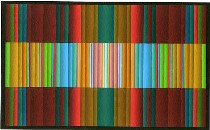
My stop to see Nancy Herman’s color-saturated pieces, based on music, at Silicon Gallery yesterday put me in mind of John Cage and Jeremy Blake, quilts and mandalas.
Turns out, quilts were pretty dead on, Herman having previously tried her system of translating music into color with quilted fabrics. In fact, the translation of music to color and pattern has been an obsession of hers for 25 years (shown, “Bach’s Minuet in D Minor”).
Herman has been looking for a system whereby each note is represented by a specific color that would then translate into an image. She’s even got a color-coded keyboard.
But the thing that struck me hardest was how different her approach was in setting a system in motion to John Cage, who put forth his systems and then stuck to them, pleased with the products even if they were ungainly and unpretty.
It took Herman 25 years because ungainly and unaesthetic are not in her vocabulary. She wanted a system but then she wanted control over the results. Fabrics and paint ultimately didn’t give her the degree of control she sought over exact color and range. This latest iteration of the venture–using computer technology–took her two years to perfect. And even so, as I understand it, she still tinkers with the image.
The pieces, printed by Silicon Gallery, which specializes in creating archival prints using computer technology, are saturated with beautiful color patterns–columns or squares. The columnar versions have a soothing glow and pace, and seem like a stop-action cousin to Jeremy Blake‘s computer art, although not as spatial or architectural, and more about the pattern. The grids are jumpier, radiating out in four directions from a center, as in log cabin pattern meets Tibetan tanka.
 Each piece of music that Herman translated, she approached two different ways–with the grid/mandala versions and the horizontal-column versions. So each eight bars of music are represented by two different images–a grid and horizonal-column version–with the same predetermined colors (shown, “Mozart First Minuet”).
Each piece of music that Herman translated, she approached two different ways–with the grid/mandala versions and the horizontal-column versions. So each eight bars of music are represented by two different images–a grid and horizonal-column version–with the same predetermined colors (shown, “Mozart First Minuet”).I don’t believe I could get the feel of the specific piece of music from the images, but I liked looking. The colors were a knock-out, and the obsessional quality lifts them above their decorative force. Herman hopes to eventually covering the whole history of music in color. I love the ambition.
Herman also made a video painting of a number of pieces of music, which each started out a little slow, visually, but as the signature themes got layered and increasingly complex–a reflection of what the music did–they became quite interesting.









